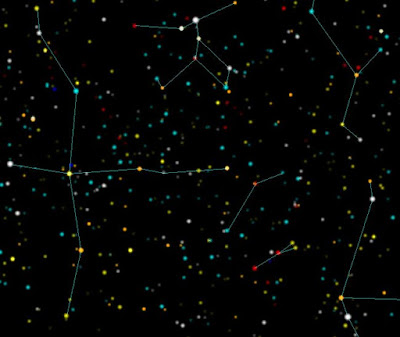The early morning sky shows us what will be in the evening sky a season later. This morning, so early in Spring, I saw the Summer Triangle, with its brightest star, Vega, right overhead.
 Vega is the bright white star at top center. It is relatively close, at 25 light years, and is an A0 dwarf (type V). If it were as close as Sirius, which is 8 light years away, it would be about 50% brighter than Sirius. As it is, it is the fifth brightest star in the night sky, at visual magnitude (Mv) of 0.03. It is the prototypical zero magnitude star. Its constellation is Lyra.
Vega is the bright white star at top center. It is relatively close, at 25 light years, and is an A0 dwarf (type V). If it were as close as Sirius, which is 8 light years away, it would be about 50% brighter than Sirius. As it is, it is the fifth brightest star in the night sky, at visual magnitude (Mv) of 0.03. It is the prototypical zero magnitude star. Its constellation is Lyra.Altair, in the Eagle constellation (Aquila), is an A7 dwarf, so it is dimmer than Sirius by half, and twice as far away (17 light years), so its Mv is 0.77, making it firmly in the first magnitude range. It is the twelfth brightest star. You'll find it at lower right, the only bright white star in the vicinity.
Deneb, the tail of the Swan (Cygnus), is at center left. It is no dwarf. Rather it is an A2 supergiant at a distance of 3,000 light years. This distance dims it to Mv of 1.24, making it the nineteenth brightest star. Were it as close as red Betelgeuse (430 light years), it would be 4.2 magnitudes brighter than it is, at -3. Only Venus at its brightest (plus Moon and Sun) gets brighter than that. Though it seems a second-rate star, it is intrinsically the brightest star among the brightest 300 stars.
The designations "dwarf" and "giant" are historical in nature, and refer to the luminosity of a star of a particular color. Most stars are yellowish to orange in color, and among them there is a very distinct set of brightness ranges. Those few that are bluish, with few exceptions, are all at least giants, and many are supergiants. The dividing line is stars of color A, which are considered "white" when viewed from the ground. But the atmosphere scatters most of the blue light from stars, so the "yellow" star we call the Sun is actually very white, and an A star such as Sirius (or the three Summer Triangle stars), is distinctly bluish when seen from space.
To delve more into the sizes and colors and luminosities of stars, look here for a good discussion of the Hertzsprung-Russell diagram and how stars' characteristics are shown on it.



No comments:
Post a Comment